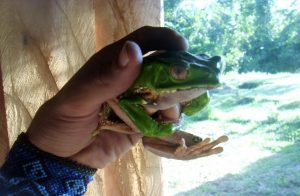- New Urban Practices Around Kambô - July 25, 2018
- New Urban Practices Around Kambô - July 25, 2018
What is this substance, and what does this secretion of a frog—spread on a global scale and claimed to be able to heal an extensive list of physical, psychological, and spiritual diseases—do? What is kambô? Nowadays, we see people advertising kambô applications in different countries, being considered experts on the subject, and promoting individual or collective sessions for which they pay between 100 and 300 dollars. We also see the emergence of associations responsible for training urban applicators and for legitimizing the practice in these contexts. Who has information more accurate than the attractive advertisements? As anthropologists with empirical experience with the native use of kambô, especially among Panoan language groups, we are intrigued by the various forms of kambô reinvention in large urban centers around the world. They are recent innovations, since, in the traditional use as realized by the indigenous inhabitants in the villages, among the connoisseurs of the practice, kambô is related to hunting and the elimination of the panema (bad luck in the hunt).

So, starting from the beginning, the cutaneous application of the secretion of kambô, the giant frog—scientifically named Phyllomedusa bicolor—is well distributed among Amazonian indigenous groups, most of them belonging to the Panoan linguistic family who inhabit the southwest region of Amazonia, but is not only used among them. From the ethnological literature, the use of kambô is registered in more than 15 indigenous groups belonging to five linguistic families—Pano, Aruak, Arawa, Tikuna and Tupi-Guarani—located within three national borders: Brazil, Peru, and French Guiana. In the article entitled Le fleuve Muru [The Muru River] (1925), the French missionary Constantin Tastevin, who was in Upper Juruá at the beginning of the last century, described the use of kambô in indigenous groups inhabiting the region. This was probably the first record of the use of secretion. Since this first record, information on the use of the kambô has accumulated and continued to grow, with exponential growth in the most recent years, while spreading to other places.

Collecting kambô secretion is a task that does not involve major difficulties. The search for the amphibian occurs at dawn, and the person responsible for finding it is guided by the characteristic and peculiar sound emitted by the frog. As it moves slowly, usually in the vicinity of streams, catching it is easy. After the capture, the hind and front legs of the frog are tied in branches, stretching it by the extremities, forming an “x,” as in the image below. Then the collector seeks to provoke the amphibian, usually with spits or poking, so that the secretion in the skin is released. At that moment, the skin of the frog is carefully scraped with a small wooden rod to remove the secretion, which can be used soon after or stored in sticks. After the collection, the kambô frog is returned to the forest.
The use of kambô, as said at the beginning, is done by cutaneous applications. The applicator superficially burns the skin of the person who will receive the secretion with a smoldering stick, called regionally of “cipó titica,” making “points” (the name given to the superficial burns) on the skin of the person. Then, the secretion is deposited on such “points.” Applications are preferably performed at sunrise. It is recommended that the person who is going to receive the kambô should drink about one to two liters of caiçuma until the stomach is full and nausea is induced.

Traditionally, among the natives, the role of kambô applicator cannot be occupied by just any person. In indigenous groups on which ethnographic records are available, it is invariably found that, among men, the application must be carried out by hunters with years of experience who are virtuous and successful in practice. It is only with this knowledge about that the experienced hunter is able to convey his qualities to the young man who seeks to learn and perform well on the hunt. Among women, the ideal applicators are the oldest and hardest working, reputed for the good performance of their daily activities. Due to lack of maturity, it is not recommended that young women and men perform as kambô applicators.
The physical effects following the application of kambô are very powerful and uncomfortable. Among the body effects, which begin with intense heat where the secretion has been deposited, the following are noteworthy: tachycardia, heat, slight pressure in the ears, vomiting, sometimes diarrhea, and swelling in the region of the eyes and mouth, whose intensity varies according to the number of points in which the application was made. Such physical reactions are believed to be indicative of impurities that have been expelled from the body. Sometimes it is quite strong and is not indicated for use by people with heart problems. We have collected information that at least three people died after the application: one in Brazil (2008), one in Chile (2009), and another in the US (2018).
That said, since the beginning of this century, news on the use of kambô began to circulate in magazines and newspapers of regional and national scope. Before the use of the secretion became news, the former rubber tapper Francisco Gomes—who lived near the Katukina Indians near the Rio da Liberdade in the late 1960s—appears to be the main person responsible for the beginning of the urban diffusion of kambô in Brazil. Francisco received the name of Shibam from the Indians and learned about the frog’s secretion during that period (Lopes, 2000). Later, the former rubber tapper went to live in Cruzeiro do Sul and began to apply kambô to inhabitants of the city.

Spreading initially in the urban environment through Francisco Gomes and later through alternative therapists linked to the ayahuasca religions, the use of the kambô quickly expanded beyond the Brazilian territory in a process similar to the one occurring with ayahuasca. From then on, the expansion of kambô did not cease, reaching large Brazilian urban centers and quickly becoming international. Expansion abroad has also reached from Peru to the United States and Europe. Its reputation as an invigorator also encouraged its use as a sexual stimulant and, unsurprisingly, in Amazonian cities, kambô was also known as the “Viagra of the forest”! It has recently been suggested as a remedy for male impotence in a popular British newspaper (Charlton, 2018).
It is possible to access varied information internationally on the internet regarding the use of kambô that ends up, in most cases, repeating what is already known about what is happening in Brazilian territory. This relative repetition of the information is most certainly due to the fact that the “ayahuasqueros” who are at the forefront of the process of internationalization are non-Indigenous therapists; it is important to note that, except for what happens in Chile, apparently there are no Indians leading or actively participating in the international diffusion. In Chile and Holland especially, kambô is always spread followed by the mention of the name of the Katukina and the Matsés, like traditional users do. Kambô is often accompanied, at least in its dissemination, by the use of ayahuasca and other practices, such as tobacco rapé, San Pedro, and iboga, without an explanation of the specificities of each of these substances, as if its qualities are directly shared among all these materials and belong to the same “shamanic universe.” Thus, such disclosures bring the kambô closer to a generic notion of shamanism.
In the spreading of this practice in the virtual world, one realizes that the kambô circulates in various forms, as a shamanic, therapeutic, and scientific object, and as a commodity. We also see the emergence of new categories and relationships around practice. If, in the native context, the relation between the applicator and the receiver is built from the accumulation of capacities in the body— that is, from the transmission of knowledge by the applicator and the possibility of learning from the receiver with the repetition of the practice and maintenance of this relationship—in the urban context, such knowledge transmission is left aside and we see relationships between the urban applicator (practitioner) and client in which such applicators are presented as experts in the subject.

Urban practitioners appear as facilitators of access to indigenous knowledge, and knowledgeable, and end up occupying the main scene of the process, becoming protagonists in these contexts, where not only does a “therapist-patient” relationship prevail, but also market relations, clientele, and a scene in which kambô has an elaborate visual presentation apparatus where it is inserted in a neo-shamanic market alongside other traditional practices and knowledge. In addition to kambô being associated with shamanic substances from different groups and places, it is common to see the frog’s secretion advanced alongside practices such as yoga, meditation, Ayurvedic medicine, reflexology, acupuncture, and chakra alignment. It is also common to see the kambô disclosed as a “medicine” capable of curing various diseases, from weakened immunity, tendinitis, asthma, rhinitis, allergy, ulcer, diabetes, constipation, blood pressure and circulation problems, high cholesterol, cirrhosis, stress, menstrual irregularity, and reduced libido, to Alzheimer’s disease, Parkinson’s disease, depression, panic attack, and HIV, among others.
Thus, the new understandings built and disseminated in the urban centers regarding kambô draw attention. In sum, it pays to get better information on the subject before believing the speeches circulating in the non-indigenous world around the practice.
BIBLIOGRAPHY
Charlton, C. (2018, March 7). Jungle juice: Bloke reckons he cured his impotence by poisoning himself with the venom of south american tree frogs. The Sun. Retrieved from https://www.thesun.co.uk/news/5747610/cute-impotence-erectile-dysfunction-poison-south-american-frog/
Labate, B. C., & Lima, E. C. (2014). Medical drug or shamanic power plant: the uses of kambô in Brazil. Ponto.Urbe, 15. Retrieved from http://journals.openedition.org/pontourbe/2384 ; DOI : 10.4000/pontourbe.2384
Lima, E. C. (2014). A internacionalização do kampô (via ayahuasca): difusão global e efeitos locais [The internationalization of kampô (via ayahuasca): global diffusion and local effects. In M. Carneiro da Cunha & P. Cesarino. (Eds.), Políticas culturais e povos indígenas [Cultural policies and indigenous people] (pp. 91–113). São Paulo: Editora da UNESP
Lima, E. C., & Labate, B. C. (2010). L’expansion urbaine du kampo (Phyllomedusa bicolor) [The urban expansion of kambô (Phyllomedusa bicolor)]. In S. Baud & C. Ghasarian (Eds.), Des plantes psychotropes. Initiations, thérapies et quêtes de soi [Psychotropic plants: Initiations, therapies and self-quests] (pp. 137–172). Paris: Imago.
Lima, E. C. (2010). Kampu, kampô, kambô: os usos do sapo-verde entre os Katukina [Kampu, kampô, kambô: The uses of the green frog among the Katukina]. In E. C. Lima & M. Coelho de Souza. (Eds.), Conhecimento e cultura: práticas de transformação no mundo indígena [Knowledge and culture: Practices of transformation in the indigenous world] (pp. 19–35). Brasília: Athalaia Gráfica e Editora.
Ribeiro, F. S. (2016). O Kambô na rede: divulgação de uma prática tradicional indígena na internet [Kambô in the network: Dissemination of a traditional indigenous practice on the internet] [Monograph]. UFPR. http://neip.info/novo/wp-content/uploads/2018/01/Ribeiro_Kambo_Internet_UFPR_2017.pdf
___
Note:
We thank Bia Labate for the invitation to collaborate with Chacruna, and Fabiano Atenas Azola for translating the article originally written in Portuguese.
Take a minute to browse our stock:
Did you enjoy reading this article?
Please support Chacruna's work by donating to us. We are an independent organization and we offer free education and advocacy for psychedelic plant medicines. We are a team of dedicated volunteers!
Can you help Chacruna advance cultural understanding around these substances?














